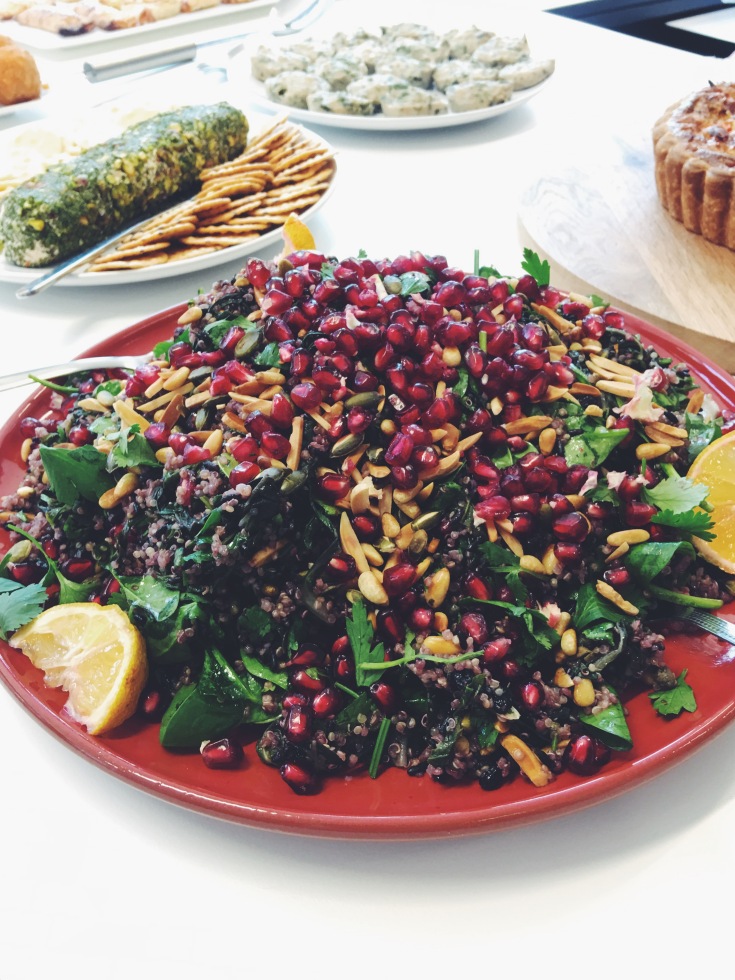Cooking for people with food allergies or a food intolerance can often seem like a daunting task, especially at Christmas-time. I’ve taken a twist on my favourite Cypriot Grain Salad from George Calombaris’ Hellenic Republic and made it gluten-free AND low FODMAP. This salad is perfect if you’re looking to make something that is simple, nutrient dense and most importantly, DELICIOUS! The nuts add a fabulous textural crunch to the grains; while the spinach and silverbeet are packed with fibre, vitamins and minerals. The beautiful jewel-like pomegranates also make this dish look especially festive!

So what are FODMAPs?
FODMAPs are a collection of naturally occurring carbohydrates and sugar alcohols found in food that may be poorly absorbed. FODMAP stands for:
- Fermentable
- Oligosaccharides (eg. Fructans and Galacto-oligosaccharides (GOS))
- Disaccharides (eg. Lactose)
- Monosaccharides (eg. excess Fructose)
- And
- Polyols (eg. Sorbitol, Mannitol, Maltitol, Xylitol and Isomalt)
Is eating a low FODMAP diet better for me?
The low FODMAP diet was developed to help reduce symptoms of irritable bowl syndrome (IBS) which may include abdominal pain, bloating and altered bowel habits. If you do not experience strong symptoms when eating high FODMAP foods, there is no need to follow this diet. Check out Sue Shepherd‘s work for more info on the diet or have a look at the Monash University website for additional information on what foods are high and low in FODMAPs. If you are concerned about your symptoms, please seek the help of an Accredited Practising Dietitian for more guidance.

How is this recipe low in FODMAPs?
To make it fructan free, I removed the onion and replaced the freekah and lentils with quinoa and black rice. Without freekah this recipe is also gluten free, making it perfect for those with coeliac disease.
This salad contains pomegranate, currants, nuts and seeds which may cause symptoms in some; however the amount of these foods per serve shouldn’t trigger IBS symptoms. If you find you’re someone who’s particularly sensitive, simply omit/reduce the amount in the recipe. Or simply serve the fruit and nuts on the side and let your guests sprinkle in as much as they like.

Ingredients:
1 bunch coriander, chopped
1/2 bunch parsley, chopped
3/4 cup quinoa
3/4 cup black rice
1 bunch silverbeet + 1 tbsp extra virgin olive oil for frying
3 tbsp toasted pumpkin seeds
3 tbsp toasted slivered almonds
3 tbsp toasted pine nuts
2 tbsp baby capers
1/4 cup currants
Juice of 1 lemon
3 tbsp extra virgin olive
Salt and pepper to taste
120g washed baby spinach, to serve (more if you like)
1 pomegranate, deseeded or 1 packet of pomegranate arils, to serve*
Dressing
1 cup lactose-free** yogurt
1 tsp ground cumin
1 tbsp maple syrup
*Pomegranate may be high in fructose, however <1/4 cup per serve is a well tolerated amount
**If making for coeliacs make sure that the brand you’re using doesn’t also contain gluten. Liddell’s is a lactose-free variety but it does contain gluten. If you’re not lactose intolerant I would suggest using a thick Greek yogurt in place of the lactose-free variety because it’s so yummy!
Method:
- Cook quinoa and black rice separately in boiling water with a pinch of salt until both are just cooked. Drain well and allow to cool.
- Heat 1 tbs olive oil in a pan on medium heat and add silverbeet. Cook for 3 minutes until slightly wilted. Remove from heat.
- Combine the yogurt, ground cumin and maple syrup and set aside.
- In a large bowl, place the coriander, parsley, quinoa, rice, toasted nuts and seeds, capers, currants, silverbeet, baby spinach, lemon juice and olive oil. Mix well and season to taste.
- Place into serving dish and top with cumin yogurt and pomegranate seeds.
- Enjoy!
